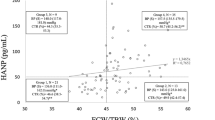Abstract
The authors performed bioimpedance analysis and Cardio Tens (24-h ABPM and ECG) monitoring in 66 patients (28 males, 38 females) treated in the chronic haemodialysis programme. They investigated the correlations between the body weights before, during and after dialysis, the changes of the water compartments and fat body weight, and the recorded values of blood pressure and ECG alterations. On the basis of the measurements by this non-invasive method it is concluded that, as a result of dialysis and ultrafiltration, the total body weight and total body water are decreasing in a greater extent in men than in women. By gradually decreasing the body weight, the optimal dry weight could be attained, which resulted in the reduction of blood pressure or even normotension. In the course of dialysis the values of bioimpedance and bioreactance increase. The intradialytic hypotensive indispositions were accompanied by a significant reduction of bioreactance (n=16). The BMI, total body weight and total body water hyperlipidaemic, hypalbuminic patients with treatment-resistant hypertension are considerably larger than those of the patients with normal blood pressure (p<0.01). During Cardio Tens monitoring 53% of the patients proved to be dippers, 47% of whom had ST depression, while in 73% of the non-dippers ischaemic alterations were encountered together with high hyperbaric impact values. The total body weights and total water compartments of patients returning to dialysis with an excess body weight of more than 3.5 kg were significantly larger than of patients who were cooperative and had no oedemas. In the last hour of dialysis and during the following few hours, arrhythmias and ST depressions of the cardiovascularly instable patients appeared more frequently. The total water compartments of these patients are significantly larger than normotensive, normolipaemic patients with appropriate serum albumin concentrations. The importance of the BIA and Cardio Tens monitoring in determining the optimal dry body weight and improving the cardiovascular condition of the patients is emphasized.
Similar content being viewed by others
References
Bazzato, G., Landini, S., Fracasso, A., Morachiello, P., Righetto, F., Scanferla, F., Toffoletto, P. P., Genchi, R., Roncali, D.: Bioimpedance to assess adequate dialysis. In: Blood Purification in Perspective: New Insights and Future Trends. Vol. II. ICAOT Press, Cleveland 1992, pp. 319–322.
Biasoli, S., Foroni, R., Petrosino, L., Cavallini, L., Zambello, A., Cavalcanti, G., Talluri, T.: Effect of aging on the body composition of dialyzed subjects — comparison with normal subjects. Am. Soc. Art. Int. Org., 39, 596 (1993).
Charra, B., Laurent, G., Chazot, C., Calemard, E., Terrat, J. C., Vanel, T., Jean, G., Ruffet, M.: Clinical assessment of dry weight. Nephrol. Dial. Transplant. 11, 16 (1996).
Donadio, C., Lucchesi, A., Tramonnti, G., Bianchi, C.: Creatinine clearance predicted from body cell mass is a good indicator of renal function. Kidney Int., 52, 166 (1997).
Dumler, F., Schmidt, R., Kilates, C., Faber, M., Lubkowski, T., Frinak, S.: Use of bioelectrical impedance for the nutritional assessment of chronic hemodialysis patients. Miner. Electrol. Metab., 18, 284 (1992).
Foster, K. F., Lukaski, H. C.: Whole-body impedance — What does it measure? Am. J. Clin. Nutr., 64, 388 (1996).
Kushner, R. F., De Vries, P. M. J. M., Gudivaka, R.: Use of bioelectrical impedance analysis measurements in the clinical management of patients undergoing dialysis. Am. J. Clin. Nutr., 64, 503S (1996).
Kushner, R. F.: Bioelectrical impedance analysis: A review of principles and applications. J. Am. Coll. Nutr., 11, 199 (1992).
Ligtenberg, G., Barnas, M. G. W., Koomans, H. A.: Intradialytic hypotension — new insights into the mechanism of vasovagal syncope. Nephrol. Dial. Transplant, 13, 2745 (1998).
Lukaski, H. C.: Methods for the assessment of human body composition: Traditional and new. Am. J. Clin. Nutr., 46, 537 (1987).
Lukaski, H. C., Johnson, P. E., Bolonchuk, W. W., Lykken, G. I.: Assessment of fat-free mass using bioclectrical impedance measurements of the human body. Am. J. Clin. Nutr., 41, 810 (1985).
Oe, B., De Fijter, C. W. H., Oe, P. L., Stevens, P., De Vries, P. M. J. M.: Diameter of inferior caval vein (VCD) and bioelectrical impedance analysis (BIA) for the analysis of hydration status in patients on hemodialysis. Clinical Nephrology, 50, 38 (1998).
Passauer, J., Büssemaker, E., Gross, P.: Dialysis hypotension: Do we see light at the end of the tunnel? Nephrol. Dial. Transplant, 13, 3024 (1998).
Piccoli, A., Brunani, A., Savia, G., Pillon, L., Favaro, E., Berselli, M. E., Cavagnini, F.: Discriminating between body fat and fluid changes in the obese adult using bioimpedance vector analysis. Inter. Journ. Obesity, 22, 97 (1998).
Piccoli, A.: For the Italian Hemodialysis — Bioelectrical Impedance Analysis (HD-BIA): Identification of operational clues to dry weight prescription in hemodialysis using bioimpedance vector analysis. Kidney Intern., 53, 1036 (1998).
Piccoli, A., Rossi, B., Pillon, L., Bucciante, G.: A new method for monitoring body fluid variation by bioimpedance analysis: The Rxc graph. Kidney Intern., 46, 534 (1994).
Talluri, A., Maggia, G.: Bioimpedance analysis (BIA) in hemodialysis patients: Technical aspects. Intern. J. Artif. Org., 18, 687 (1995).
Tedner, B., Lins, L. E.: Fluid volume monitoring with electrical impedance technique during hemodialysis. Artif. Organs, 8, 66 (1984)
Author information
Authors and Affiliations
Rights and permissions
About this article
Cite this article
Löcsey, L., Szlanka, B., Ménes, I. et al. The Importance of Bioimpedance (BIA) Analysis and Cardio Tens (24-h ABPM and ECG) Monitoring in the Dialysis Programme. Int Urol Nephrol 31, 547–555 (1999). https://doi.org/10.1023/A:1007131815673
Issue Date:
DOI: https://doi.org/10.1023/A:1007131815673




